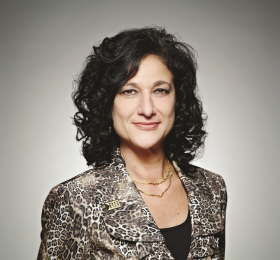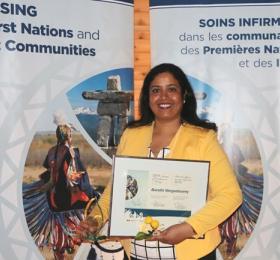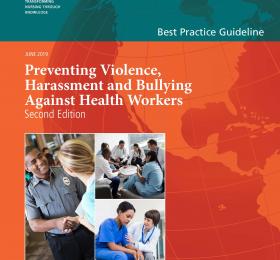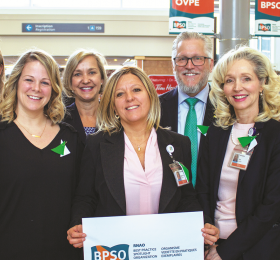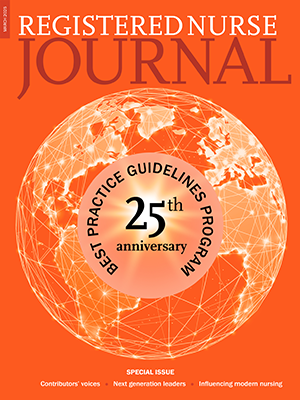Leadership award for former RNAO president
In June, Vanessa Burkoski received a 2019 Nursing Leadership Award from the Canadian College of Health Leaders. The RNAO past-president, who is chief nurse executive for Humber River Hospital (HRH), as well as chief for its People Strategy, was recognized for her vision and leadership in the execution of several HRH initiatives, including: a patient safety plan; the creation of patient care councils that allow teams of patient and family advisors to collaborate with care providers on quality improvement initiatives; and the launch of an annual scholarly practice day to recognize innovation among staff. The award acknowledges Burkoski for her ongoing commitment to excellence in patient-centred care, innovation and leadership.
Recognizing work with Indigenous communities
In May, RNAO member Barathi Vengadasamy received an Indigenous Services Canada Award of Excellence in Nursing. The honour recognizes the dedication and initiative of nurses “…to improving the health of First Nations and Inuit,” Seamus O’Regan, minister of Indigenous Services, said in a media release. Former RNAO member Janet McKenzie, a First Nations Cree nurse practising in her home community, was also recognized. The work of this year’s winners is “…an inspiration, and improves the quality of life in the communities you serve,” O’Regan said. Vengadasamy and McKenzie were nominated by their peers.
Workplace violence BPG launches
The second edition of RNAO’s best practice guideline (BPG) on violence, harassment and bullying against health workers is now available online. This edition combines two previous guidelines: Preventing and Managing Violence in the Workplace (2009) and Workplace Health, Safety and Well-being of the Nurse (2008). It also delves into bullying more directly than the previous BPGs, and addresses the serious health issues bullying can cause. Issues of violence and harassment in the workplace continue to put health-care workers and quality care at risk, and developing prevention strategies is vital to reducing negative incidents, says Henrietta Van hulle, one of the two expert panel co-chairs. “There are a variety of prevention efforts that can improve potential negative outcomes related to workplace violence,” she says. “It is my hope this BPG will ensure caregivers are cared for, so they can provide the kind of exceptional care that led them to a health-care career.”
This BPG marks RNAO’s full transition to the GRADE methodology, placing the association at the forefront of international standards. Visit RNAO.ca/BPG for your free download.
NP represents Canada on international board
NP and former RNAO policy analyst Valerie Rzepka (far right) has joined the board of directors of the World Association for Disaster and Emergency Medicine (WADEM) Nursing Special Interest Group. In the role, she will collaborate with an international team of nursing experts to improve practice and knowledge around disaster nursing. Rzepka first got involved in disaster nursing in 2004. She co-founded and is now executive director for the Canadian Medical Assistance Teams, a grassroots humanitarian relief organization. Rzepka applied for the position with WADEM because she finds there is too much focus on the medical model in disaster response: “I feel there needs to be a lot more of a nursing presence because nurses are the ones delivering most of the care during a disaster.” The special interest group includes representatives from Botswana, Canada, Israel, Japan, Tanzania and the U.S.
Newest BPSO cohort
In April, RNAO honoured its newest cohort of BPSOs in long-term care representing 18 nursing homes, and one organization in Jamaica.
The Ontario organizations are: Grove Park Home; Tilbury Manor; The Perley and Rideau Veterans’ Health Centre; William A. George Extended Care Facility; the Regional Municipality of Halton and its homes: Allendale, Post Inn Village, and Creek Way Village; Woodingford Lodge and its homes: Ingersoll, Woodstock, and Tillsonburg; and the Regional Municipality of Niagara and its homes: Linhaven, Gilmore Lodge, Northland Pointe, Deer Park Villa, Upper Canada Lodge, Woodlands of Sunset, Meadows of Dorchester, and Douglas H. Rapelje Lodge.
The international BPSO is: University Hospital of the West Indies in Jamaica. The south Australian branch of the Australian Nursing and Midwifery Federation renewed its commitment as a BPSO.
Ostomy guideline marks milestone
In April, RNAO released Supporting Adults Who Anticipate or Live with an Ostomy, the next edition of the 2009 best practice guideline (BPG), Ostomy Care and Management. This edition provides nurses and other members of the interprofessional team with evidence-based recommendations to support patients, enhance access to care, promote positive outcomes, and enable patients to better manage their condition.
The guideline’s expert panel recommends that people who have or expect to have an ostomy consult with nurses who specialize in wound, ostomy and continence as members of an interprofessional team. This means that, before surgery, these specialized nurses educate and counsel patients.
The panel also recommends health service organizations standardize care for ostomy so interprofessional teams counsel patients on how to care for themselves, adapt new approaches to daily living, and deal with potential complications. The interprofessional team should also plan discharge based on the readiness of patients, then schedule home visits and telephone calls within four weeks of discharge.
The BPG includes strategies to prevent one of the the most common complications of ostomy: when one or more loops of the intestine protrude through the abdominal wall, creating a bulge around the peristomal skin, something called parastomal hernias.
The panel recommends providers assess the quality of life in persons who have or expect to have an ostomy and focus on areas such as self-identity, sexuality and psychological well-being.
This latest guideline marks a milestone for RNAO’s BPG program, which is improving and streamlining how it formulates questions and researches recommendations so BPGs prove even more useful. Using a proven methodology called GRADE from this BPG onwards – including all next editions and new ones – each BPG panel will harness the expertise of its members to craft pointed practice recommendations for the most salient issues they want to tackle. RNAO’s guideline development methodologists then turn those into the research questions for systematic review. Expert panels tether recommendations more closely to evidence and report the strengths and limitations of each recommendation. The new approach results in fewer and sharper recommendations. In the case of this new ostomy BPG it has six rated recommendations, instead of the 26 included in the 2009 version.
For a free download, visit RNAO.ca/BPG/guidelines/ostomy.
Francophone first
RNAO has named its first Best Practice Spotlight Organization (BPSO) Host that will be responsible for bringing francophone organizations into the BPSO movement. Hôpital Montfort, Ontario’s francophone academic hospital, offers health services in both official languages to more than 1.2 million people across eastern Ontario.
This BPSO designation comes after many years of partnership that has seen Hôpital Montfort implement nine best practice guidelines (BPG). The hospital has become a go-to source for francophone organizations in Canada and around the world.
“What RNAO has developed is a jewel for us,” says Suzanne Robichaud, chief nursing officer and vice president in charge of clinical services. The hospital continues to expand its use of BPGs with plans next year to add pain management and the prevention of suicide, she adds. “My vision is to become a lab of exemplary practice.”
That aim is already being realized with some francophone organizations coming to Montfort, which is based in Ottawa, from as far away as Switzerland and the northeast African nation of Djibouti, Robichaud says.
This work with RNAO is critical, Hôpital Montfort CEO and family physician Bernard Leduc says. “Because we are the only francophone teaching hospital in Ontario, it’s crucial we adopt best practices in all areas.”
That work has garnered attention, especially in Quebec, he says.
The hospital readily embraced RNAO and its BPGs because of its strong nursing leadership, he adds. “It’s a great partnership.”
Studying the science of cannabis
Beginning in May, 2019, McMaster University will offer a new, three-course certificate program – one of the first in Canada – focused on the science of cannabis. Health-care professionals, first responders, educators, and social and community service professionals are among those expected to benefit from the program, which offers an evidence-based approach to understanding the substance and its therapeutic applications, as well as potential risks and harms. The program is offered through the university’s continuing education arm and students must complete all three courses to qualify for the Science of Cannabis Certificate of Completion. “We know the scientific study of cannabis is something that individuals from physicians to social workers to first responders will be interested in,” says Lorraine Carter, Director of McMaster Continuing Education. “The program will help demonstrate how cannabis research interacts with fields such as addictions, mental health and public policy.” To find out more, visit mcmastercce.ca
Hoskins’ interim pharmacare report
In March, the federal government’s Advisory Council on the Implementation of National Pharmacare released its interim report, which included three recommendations: create a national drug agency; develop an evidence-based list of prescribed drugs; and invest in drug data and information technology systems. The council, which is headed by former Ontario health minister Eric Hoskins, is expected to release its final report in June. While RNAO has long advocated for a national pharmacare strategy, it believes the council needs to go further than the interim recommendations it released in March. “The federal government must ensure that all Canadians get equitable access to medication,” says RNAO President Angela Cooper Brathwaite. With the release of the interim report, Hoskins said current drug coverage is “…inadequate, unsustainable and leaves too many Canadians behind.” RNAO agrees, and has outlined its suggestions for next steps. The public system must: create universal coverage of medically necessary drugs via a single-payer system without user fees or other costs to Canadians; implement full coverage immediately; tame drug costs by creating a national agency to negotiate prices and resist excessive patent protection; and ensure appropriate prescribing. Further work on a national pharmacare strategy must also be grounded in the fact that a single-payer system is more equitable and cost-effective. To find out more, visit RNAO.ca/pharmacare_interim_report
Golden Girls Act to help seniors access shared housing
Seniors in Ontario often face a shortage of affordable housing and long wait lists for long-term care. Shared housing is an option for many seniors. In Port Perry, four women – two of them retired RNs -- decided to move into a renovated home that would support their needs as they age. The four women, who have been nicknamed the Golden Girls of Port Perry, faced pushback from their municipal government regarding senior home-sharing because the building permit they presented to their local council violated zoning bylaws that did not allow for a communal dwelling. They voiced their concerns first to the Ontario Human Rights Commission, then to their MPP, Lindsey Park, who took their concerns one step further by introducing a private member’s bill that, if passed, will ensure municipalities interpret the Ontario Planning Act in a way that encourages home-sharing by unrelated seniors as an affordable housing solution. Bill 69, also known as The Golden Girls Act 2019, was introduced by Park in January 2019, and passed second reading on Feb. 28. RNAO CEO Doris Grinspun shared nurses’ support of the proposed legislation at a media conference on the same day at Queen’s Park.

